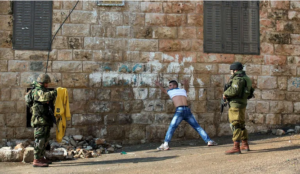The West Bank occupation outweighed Israel’s defense of the Gaza border on the eve of October 7

Israeli soldiers stop and check a Palestinian man near the Jewish settlement of Beit Hadassah, in the centre of the city of Hebron, West Bank
Aluf Benn writes in Haaretz on 21 February 2024:
Reading the numbers is physically painful, but it’s both wrong and impossible to ignore them.
On October 7, the Israel Defense Forces had 400 combat soldiers and a dozen tanks stationed on the border of the Gaza Strip facing thousands of Hamas fighters. A larger force, four or five battalions, was deployed on the Lebanese border, but it was also numerically inferior to Hezbollah (Amos Harel, Haaretz, February 16).
Yet the force stationed in the West Bank on that day was much larger, 21 or 22 battalions. It was even bolstered at the last minute with two companies from the Southern Command’s reserve due to tensions over the sukkah that MK Tzvi Succot built in Hawara.
You don’t have to be the IDF chief of staff or head of the army’s Operations Directorate to understand that defending the borders was a secondary mission for the army on the eve of the war. The military’s principal aim was defending the settlements in the West Bank – that is, maintaining the occupation and enforcing it on the Palestinians.
The occupation was allotted a force five times larger than the one in the north and 10 times larger than the one in the south. And the relative strength of these forces reflected the national order of priorities. The settlements came first, and communities in the Galilee and along the Gaza border barely made it into last place.
This massive diversion of forces to the West Bank began in March 2022, under the “government of change” led by Naftali Bennett, which was worried by a wave of terror attacks that had reached Tel Aviv and Hadera. It responded by doubling forces in the West Bank and along the “seam line” between Israel and that territory, from 15 battalions to 28 or 29 (an operation the IDF dubbed Break the Wave). This force was later thinned out a bit, after the attacks in Israel died down.
At the end of that year, Benjamin Netanyahu returned to power at the head of a fully right-wing government. The government’s guidelines declared that the Jewish people had exclusive rights to “the entirety of the Land of Israel,” and then Netanyahu appointed Bezalel Smotrich and Itamar Ben-Gvir to key posts. From then on, it was clear that protecting the settlements was the supreme military mission.
In retrospect, it’s clear that the army’s enslavement to the protection of the settlements and the fact that the north and south had been emptied of combat troops were among the main causes of the catastrophe on October 7. The enemy understood quite well what an opportunity had fallen into its lap.
In an interview in late August, senior Hamas official Saleh al-Arouri (now deceased) said that most of Israel’s regular forces – 30 battalions – were in the West Bank, while only a small number were stationed along the Gaza border. “That’s an operational consideration for acting now,” he added (according to Dr. Matti Steinberg’s Hebrew translation of the original Arabic).
But in Israel, there was no public debate over the implementation of the country’s security doctrine. Neither the cabinet, the Knesset, the anti-government protesters nor the media raised questions about the army’s deployment and its significance.
They trusted that everything would be okay, even after Defense Minister Yoav Gallant (openly) and the head of Military Intelligence’s research department (privately) warned the prime minister that a war was going to break out. As for al-Arouri’s warning, it was dismissed as the boasting of a prattler “who knows why he’s in hiding,” as Netanyahu said contemptuously.
Over the last year, Netanyahu has appeared to be embroiled in conflict with the heads of the defense establishment and the intelligence community. Initially, this was because of his government’s planned judicial overhaul; after the war broke out, it was over the question of responsibility for the failures.
But at the moment of truth, when decisions were made about where to station battalions and where not to, the IDF obeyed the government’s orders without any protest or disagreement. And in this, too, there’s nothing new.
After returning to civilian life, some former generals and senior intelligence officials beat their breasts and speak out against the occupation in interviews with Dror Moreh (see his film “The Gatekeepers”).
But while they’re in uniform and in their offices, they understand and accept the political directive that puts defending the settlers and oppressing the Palestinians at the top of their missions list. Even when a simple calculation would show them that this means abandoning the Negev and the Galilee.
This article is reproduced in its entirety
